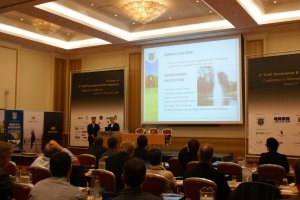
The Second Golf Investment and Development Conference to concentrate on golf in Central and Eastern Europe was held in Warsaw from 13th – 15th September. Sponsored by KPMG’s Golf Advisory Practice, Noble Bank and Hurdzan Fry Environmental Golf Design, the programme included an international team of extremely well-qualified speakers covering a wide range of topics.
For the potential golf developer there was invaluable information about creating the development team, site selection, planning ahead for a successful golf course project and minimising construction costs. For existing operators there was invaluable advice about golf club management and golf course maintenance. For everyone, no matter where they might be in the golf business cycle, there was a wealth of good ideas about everything from sustainability to the importance of attracting women and young people to the sport.
A detailed case study about the development of the Lubker Golf Resort in Denmark revealed the innovative approach that ensured that the project was fully funded in advance of construction and revealed many details about how the real estate at the Resort was brought to market and is now managed on an ongoing basis.
Gabor Szorad from KPMG set the scene by describing golf supply and demand in the Central and Eastern European area (Bulgaria, Croatia, Czech Republic, Hungary, Poland, Romania, Slovakia and Slovenia). There are now over 150 golf courses and around 66,000 golfers in the region as a whole but the Czech Republic is by far the most developed of these countries and Poland, although large in both area and population, has so far lagged behind.
This point was not denied by Marek Michalowski, President of the Polish Golf Union (founded in 1993), but he pointed out that the number of golf clubs in Poland has more than doubled since 2004 when there were only 23 members clubs. This number has now grown to 49 members clubs and there are at least four new projects where construction is under way.
The sport is thus developing but Mr Michalowski agreed that there was still much to be done. “We are at the beginning of our journey,” he said, “In 2009 there were perhaps 5,000 players registered as members or green card holders. In the next 10 years we aim to have at least 50,000 registered players and by 2016 to have at least one player who will qualify to represent Poland in the Olympic Games.”
The target may seem ambitious but in fact there is a lot of opportunity for golf development in Poland. There is a large population (38 million) and by comparison with many other countries the economy has not suffered as badly in recent years.
Scenically there are many areas of very attractive landscape that is well suited to golf and where the soil type is such that golf course construction can be undertaken at reasonable cost. Of course the climate is not exactly Mediterranean but the Polish golf season is at least two months longer than it is in many parts of Scandinavia and a trip to play golf in Poland is an attractive and easy option.
Judging by the number of golf course architects and other infrastructure providers who were present at the Conference in Warsaw there is plenty of interest in developing the Polish golf market and it is probable that real-estate led golf development will work very successfully as the country’s prosperity grows.
However, as was said many times at the Conference, it is important that the Polish Golf Union, the PGA of Poland and everyone with an interest in seeing this market develop does not neglect the provision of golf ranges, academy courses and 9 hole facilities which are affordable and accessible within 30 minutes or less from the main centres of population. If there is to be a ten fold increase in the number of Polish golfers then the opportunity to take up the sport has be spread as widely as possible.

